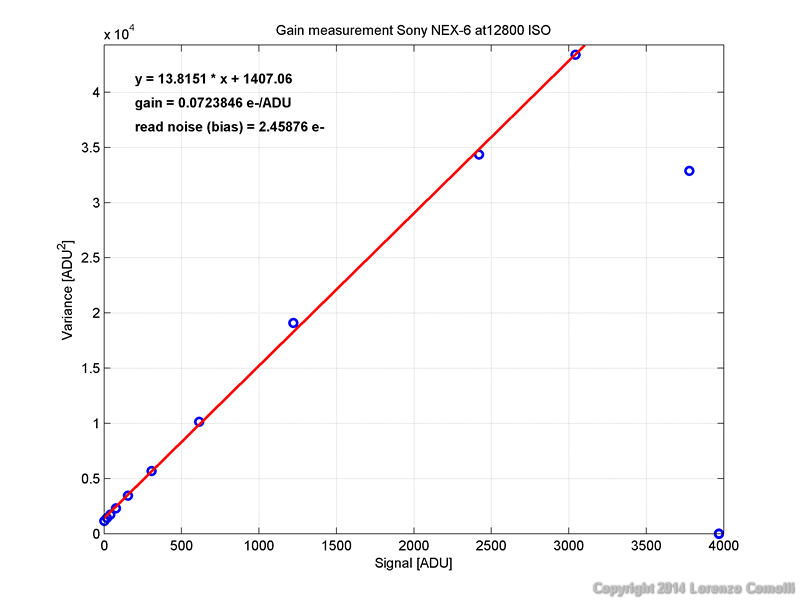|
by Lorenzo Comolli Written in December 2014 - Thanks to Emmanuele Sordini and Fabrizio Giudici for taking all the images. Thanks again to Emmanuele Sordini for the English text revisions. |

Introduction
In this page you'll find a technical test. Please refer here for an introduction, details and testing method.
Available sensitivities:
A way to distinguish between true and software-interpolated sensitivities is to look at the histogram of a nearly uniform image (like a flat field). If, however, a nonlinear compression of the histogram is applied to the RAW files, then it becomes difficult to understand what is really true. Anyway, by looking at the histograms of the bias frames (see figures below), we can suppose the following:
In this page you'll find a technical test. Please refer here for an introduction, details and testing method.
Available sensitivities:
- standard: from 100 to 25600 ISO with 1 EV steps
- extended: none
-
Gain. The gains measured follow quite accurately the power law.
- Unity gain at 904 ISO
- Read noise. A
constant
decrease in noise is found up to 800 ISO. Using 1600 ISO or more
produces no
improvement
on the read noise. A very small decrease was detected at 25600 ISO,
but it is not a real improvement, because it is caused by the cut at
the "foot" of the histogram, or black levels clipping (in the bias
frame: average 122 ADU, std 66 ADU, max 896
ADU). So, I would advise against using sensitivities above 800 ISO in
RAW mode,
because this will reduce reduce the dynamic range without any
improvement on the dark areas. In JPG mode the 1600 ISO setting will
still produce some improvements; higher ISO values (above 1600 ISO) on
the other hand are virtually useless. Therefore for best results in
low-light scenes, stick with 800 ISO.
- Dynamic range. Considering the actual saturation level for each ISO setting, the dynamic range is computed and reported both in the table and graph below. The best dynamic range is at 100 ISO, while higher ISO values, while higher ISO values show noticeable smaller dynamic range. The absolute value of the dynamic range is impressive: 77 dB, or 12.9 EV. This is noticeably higher than any other DSLR I've tested before. This seems to be due to the very small noise at 100 ISO, as shown by the bias histograms below. For best results in bright-lit scenes, use 100 ISO.
- 1/3 stop sensitivities. Not available!
- Histograms. The light frames acquired revealed big holes in their histograms. With ADU levels at about 3/4 of the dynamic range (12 bit, 4096 ADU), it’s like if only 1 ADU out of 8 were used. I.e. if one divides 4096 by 8, only 512 levels are left, producing a 9 bit quantization. But this is not true because, in the lower part of the histogram, all values are retained in the 100-800 ISO sensitivity range; at higher sensitivities, histograms start showing some “gaps” (see figures below). This could be due to a non-linear levels compression algorithm being applied to RAW frames: this would result in the RAW format not being a true raw format! It's a pity Sony is not retaining the true RAW values read by the AD converter.
A way to distinguish between true and software-interpolated sensitivities is to look at the histogram of a nearly uniform image (like a flat field). If, however, a nonlinear compression of the histogram is applied to the RAW files, then it becomes difficult to understand what is really true. Anyway, by looking at the histograms of the bias frames (see figures below), we can suppose the following:
- 3200, 6400, 12800, 25600 ISO are not true sensitivities because af all the histogram voids, both in the light and bias frames.
- 1600 ISO shows some small gaps in the bias frame histogram. Maybe it
is the first non-true sensitivity. This is confirmed also by the
non-decreasing read noise.
- 100, 200, 400, 800 ISO are true sensitivities.
| ISO | gain | read noise | Dynamic range |
| [e-/ADU] | [e-] | [dB or 6*EV] |
|
| 100 | 8.806 | 4.878 | 77.10 |
| 200 | 4.494 | 3.537 | 74.05 |
| 400 | 2.253 | 2.891 | 69.80 |
| 800 | 1.131 | 2.545 | 64.92 |
| 1600 | 0.579 | 2.510 | 59.23 |
| 3200 | 0.287 | 2.478 | 53.23 |
| 6400 | 0.143 | 2.454 | 47.28 |
| 12800 | 0.072 | 2.459 | 41.35 |
| 25600 | 0.034 | 2.252 | 35.65 |



Histograms










